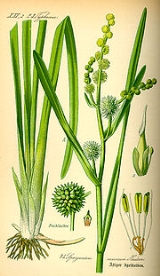
Sparganiaceae
Encyclopedia
Sparganiaceae is the botanical name
for a family
of flowering plants. Such a family was previously recognized by most taxonomists.
The APG II system
, of 2003 (unchanged from the APG system
, 1998), also recognizes this family, and assigns it to the order Poales
in the clade commelinids
, in the monocots. The family consists of only one genus Sparganium
of less than two dozen species, perennial plants of wet habitats. By the APG III system
of 2009, Sparganium had been found to be fairly closely related to Typha
, and so was placed with that genus in family Typhaceae
.
The Cronquist system
, of 1981, also recognized such a family and placed it in the order Typhales
in the subclass Commelinidae
in class Liliopsida
in division Magnoliophyta.
The Wettstein system
, last updated in 1935, placed the family in order Pandanales
.
Botanical name
A botanical name is a formal scientific name conforming to the International Code of Botanical Nomenclature and, if it concerns a plant cultigen, the additional cultivar and/or Group epithets must conform to the International Code of Nomenclature for Cultivated Plants...
for a family
Family (biology)
In biological classification, family is* a taxonomic rank. Other well-known ranks are life, domain, kingdom, phylum, class, order, genus, and species, with family fitting between order and genus. As for the other well-known ranks, there is the option of an immediately lower rank, indicated by the...
of flowering plants. Such a family was previously recognized by most taxonomists.
The APG II system
APG II system
The APG II system of plant classification is the second, now obsolete, version of a modern, mostly molecular-based, system of plant taxonomy that was published in April 2003 by the Angiosperm Phylogeny Group. It was a revision of the first APG system, published in 1998, and was superseded in 2009...
, of 2003 (unchanged from the APG system
APG system
The APG system of plant classification is the first, now obsolete, version of a modern, mostly molecular-based, system of plant taxonomy that was published in 1998 by the Angiosperm Phylogeny Group. It was superseded in 2003 by a revision, the APG II system, and then in 2009 by a further...
, 1998), also recognizes this family, and assigns it to the order Poales
Poales
Poales is a large order of flowering plants in the monocotyledons, and includes families of plants such as the grasses, bromeliads, and sedges. Sixteen plant families are currently recognized by botanists to be part of Poales....
in the clade commelinids
Commelinids
In plant taxonomy, commelinids is a name used by the APG III system for a clade within the monocots, which in its turn is a clade within the angiosperms. The commelinids are the only clade that the APG has informally named within the monocots...
, in the monocots. The family consists of only one genus Sparganium
Sparganium
Sparganium is a genus of flowering plants, containing about 20 species in temperate regions of both the Northern and Southern Hemispheres. It was previously placed alone in the family Sparganiaceae...
of less than two dozen species, perennial plants of wet habitats. By the APG III system
APG III system
The APG III system of flowering plant classification is the third version of a modern, mostly molecular-based, system of plant taxonomy...
of 2009, Sparganium had been found to be fairly closely related to Typha
Typha
Typha is a genus of about eleven species of monocotyledonous flowering plants in the family Typhaceae. The genus has a largely Northern Hemisphere distribution, but is essentially cosmopolitan, being found in a variety of wetland habitats...
, and so was placed with that genus in family Typhaceae
Typhaceae
Typhaceae is the botanical name for a family of flowering plants. Such a family has been recognized by most taxonomists.The APG II system, of 2003 , also recognizes this family, and assigns it to the order Poales in the clade commelinids, in the monocots...
.
The Cronquist system
Cronquist system
The Cronquist system is a taxonomic classification system of flowering plants. It was developed by Arthur Cronquist in his texts An Integrated System of Classification of Flowering Plants and The Evolution and Classification of Flowering Plants .Cronquist's system places flowering plants into two...
, of 1981, also recognized such a family and placed it in the order Typhales
Typhales
Typhales is a botanical name for an order of flowering plants. In the Cronquist system the name was used for an order placed in the subclass Commelinidae. The order consisted of :* order Typhales*: family Sparganiaceae...
in the subclass Commelinidae
Commelinidae
Commelinidae is a botanical name at the rank of subclass. Circumscription of the subclass will vary with the taxonomic system being used ; the only requirement being that it includes the family Commelinaceae...
in class Liliopsida
Liliopsida
Liliopsida is a botanical name for the class containing the family Liliaceae . It is considered synonymous with the name monocotyledon. Publication of the name is credited to Scopoli : see author citation...
in division Magnoliophyta.
The Wettstein system
Wettstein system
A system of plant taxonomy, the Wettstein system recognised the following main groups, according to* I. phylum Schizophyta*::: 1. classis Schizophyceae*::: 2. classis Schizomycetes* II. phylum Monadophyta* III. phylum Myxophyta...
, last updated in 1935, placed the family in order Pandanales
Pandanales
Pandanales is an order of flowering plants, with a pantropical distribution.The APG III system places the Pandanales in the monocots. Both the APG III and APG II systems include five families in this order:* Cyclanthaceae* Pandanaceae* Stemonaceae...
.
External links
- Sparganiaceae in L. Watson and M.J. Dallwitz (1992 onwards). The families of flowering plants: descriptions, illustrations, identification, information retrieval. Version: 27 April 2006. http://delta-intkey.com.
- NCBI Taxonomy Browser
- links at CSDL

